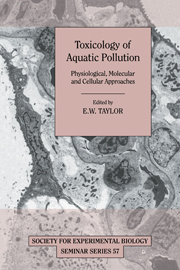Book contents
- Frontmatter
- Contents
- List of contributors
- Preface
- Water chemistry at the gill surfaces of fish and the uptake of xenobiotics
- Bioaccumulation of waterborne 1,2,4,5-tetrachlorobenzene in tissues of rainbow trout
- Dietary exposure to toxic metals in fish
- The physiology and toxicology of zinc in fish
- Lethal and sub-lethal effects of copper upon fish: a role for ammonia toxicity?
- The physiological status of brown trout exposed to aluminium in acidic soft waters
- Physiological and metabolic costs of acclimation to chronic sub-lethal acid and aluminium exposure in rainbow trout
- Physiological effects of nitrite in teleosts and crustaceans
- Metallothioneins in fish: induction and use in environmental monitoring
- Oestrogenic substances in the aquatic environment and their potential impact on animals, particularly fish
- Effect of genetic toxicants in aquatic organisms
- In vitro toxicology of aquatic pollutants: use of cultured fish cells
- Principles governing the use of cytochrome P4501A1 measurement as a pollution monitoring tool in the aquatic environment
- Index
Lethal and sub-lethal effects of copper upon fish: a role for ammonia toxicity?
Published online by Cambridge University Press: 20 May 2010
- Frontmatter
- Contents
- List of contributors
- Preface
- Water chemistry at the gill surfaces of fish and the uptake of xenobiotics
- Bioaccumulation of waterborne 1,2,4,5-tetrachlorobenzene in tissues of rainbow trout
- Dietary exposure to toxic metals in fish
- The physiology and toxicology of zinc in fish
- Lethal and sub-lethal effects of copper upon fish: a role for ammonia toxicity?
- The physiological status of brown trout exposed to aluminium in acidic soft waters
- Physiological and metabolic costs of acclimation to chronic sub-lethal acid and aluminium exposure in rainbow trout
- Physiological effects of nitrite in teleosts and crustaceans
- Metallothioneins in fish: induction and use in environmental monitoring
- Oestrogenic substances in the aquatic environment and their potential impact on animals, particularly fish
- Effect of genetic toxicants in aquatic organisms
- In vitro toxicology of aquatic pollutants: use of cultured fish cells
- Principles governing the use of cytochrome P4501A1 measurement as a pollution monitoring tool in the aquatic environment
- Index
Summary
Copper in the aquatic environment
Although traces of copper are essential constituents of some enzymes, copper is toxic to both animals and plants at levels only just in excess of those found in many unpolluted aquatic environments. Levels of dissolved copper are often increased from anthropogenic origins such as mine washings and direct application as an algicide, molluscicide or anti-fouling agent. Natural rock weathering adds about 2 χ 105 tonnes yr−1 of copper into the river systems of the world. In comparison Bowen (1979) estimated an annual addition of 6.19 x 106 tonnes of copper from mining sources. Global copper emissions tripled between 1950 and 1980 (Moore and Ramamoothy, 1984) and this order of magnitude difference between anthropogenic and natural inputs has led copper to be classified as one of the more potentially hazardous heavy metals (Sposito, 1986). While copper concentration in surface waters in general rarely rises above 5μg1−1 or 0.1 μmol 1−1 (Spear & Pierce, 1979), in common with other heavy metals, copper is mobilized during acid episodes. Thus, particularly in those soft, poorly buffered waters that are prone to acidification, copper concentrations can be significantly elevated by acid rain. Turnpenny et al. (1987) found that in mildly acidic streams in Wales, copper and zinc were more important determinants of fisheries status than the acidity itself.
Fortunately, copper can exist in natural waters in a wide variety of physico-chemical forms many of which are of low bioavailability and/or toxicity. Of the divalent ions in the first transition series, irrespective of the ligand type or concentration, copper forms the most stable organic complexes (Irving & Williams, 1953).
- Type
- Chapter
- Information
- Toxicology of Aquatic PollutionPhysiological, Molecular and Cellular Approaches, pp. 85 - 114Publisher: Cambridge University PressPrint publication year: 1996
- 12
- Cited by



